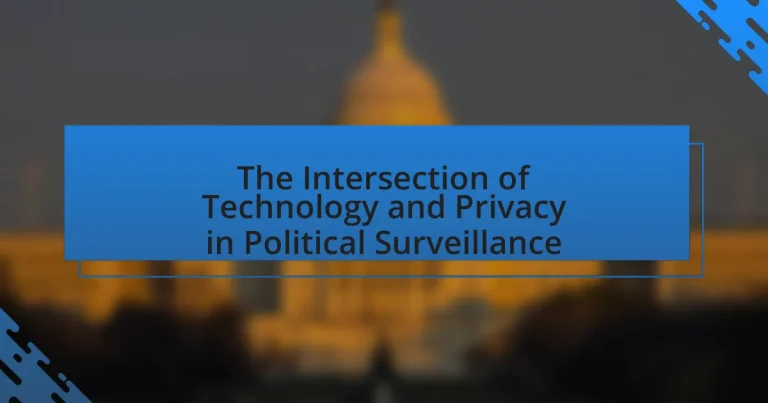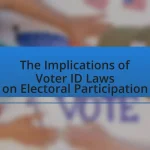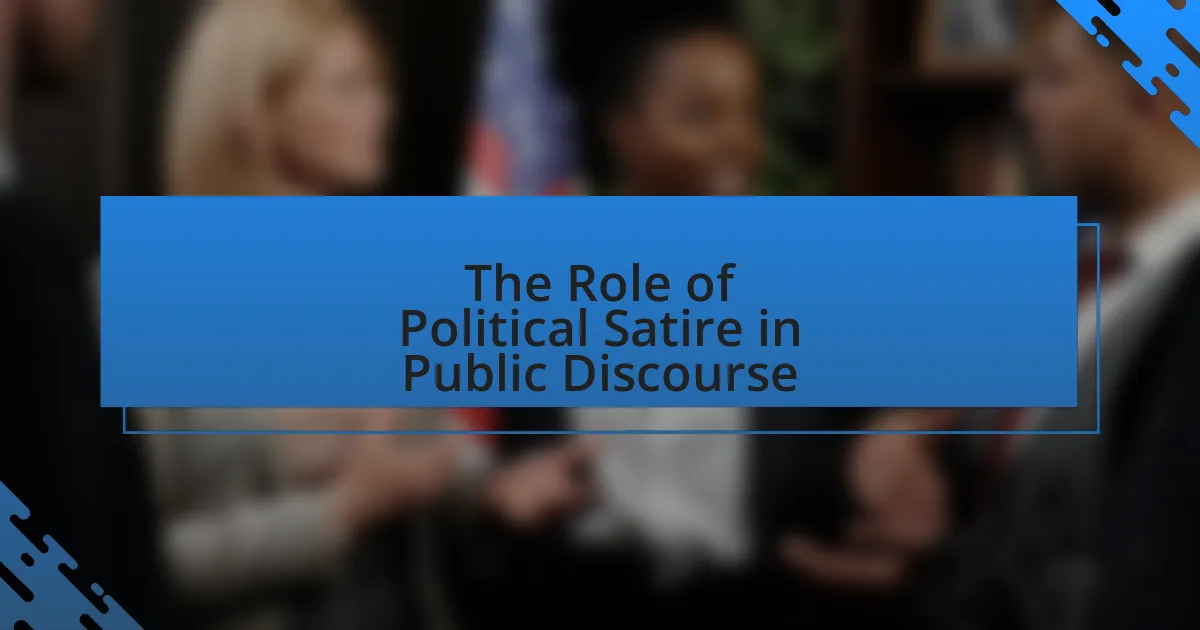The article examines the intersection of technology and privacy within the context of political surveillance, highlighting how advanced technologies such as artificial intelligence and big data analytics are utilized by governments to monitor individuals and groups, often infringing on personal privacy rights. It discusses the evolution of surveillance technologies, including facial recognition and biometric systems, and their implications for civil liberties and individual privacy. The article also explores the ethical considerations surrounding surveillance practices, the varying approaches of different political systems to privacy, and the potential consequences of increased surveillance on society. Additionally, it outlines measures individuals can take to protect their privacy and the role of public advocacy in shaping future privacy protections.

What is the Intersection of Technology and Privacy in Political Surveillance?
The intersection of technology and privacy in political surveillance involves the use of advanced technologies, such as artificial intelligence and big data analytics, to monitor individuals and groups, often infringing on personal privacy rights. Governments and organizations utilize these technologies to collect, analyze, and store vast amounts of data, which can lead to the erosion of civil liberties and the potential for abuse. For instance, the implementation of facial recognition systems in public spaces has raised significant concerns regarding consent and the extent of surveillance, as evidenced by reports from organizations like the Electronic Frontier Foundation, which highlight cases where such technologies have been deployed without adequate legal frameworks or oversight.
How has technology evolved to impact political surveillance?
Technology has evolved significantly to enhance political surveillance through advancements in data collection, processing, and analysis. The proliferation of digital communication platforms, social media, and mobile devices has enabled governments to gather vast amounts of personal data on citizens. For instance, the use of algorithms and artificial intelligence allows for real-time monitoring and analysis of online activities, making it easier to identify dissent and track political movements. Additionally, the development of surveillance technologies such as facial recognition and biometric systems has increased the capability of state actors to monitor individuals in public spaces. Reports indicate that countries like China have implemented extensive surveillance systems, utilizing millions of cameras equipped with facial recognition technology to maintain social control. This evolution in technology has raised significant concerns regarding privacy rights and civil liberties, as the line between security and surveillance continues to blur.
What technological advancements are most influential in political surveillance?
Artificial intelligence (AI), big data analytics, and advanced surveillance technologies are the most influential technological advancements in political surveillance. AI enables the processing of vast amounts of data to identify patterns and predict behaviors, enhancing the effectiveness of surveillance operations. Big data analytics allows governments to aggregate and analyze information from various sources, including social media and public records, to monitor citizens more comprehensively. Advanced surveillance technologies, such as facial recognition systems and drones, provide real-time monitoring capabilities, increasing the reach and efficiency of surveillance efforts. For instance, a report by the Electronic Frontier Foundation highlights that AI-driven facial recognition technology has been adopted by law enforcement agencies, raising concerns about privacy and civil liberties.
How do these advancements change the landscape of privacy?
Advancements in technology, particularly in data collection and surveillance capabilities, significantly alter the landscape of privacy by enabling unprecedented levels of monitoring and data analysis. For instance, the integration of artificial intelligence in surveillance systems allows for real-time analysis of vast amounts of data, making it easier for governments to track individuals’ movements and behaviors. According to a report by the Electronic Frontier Foundation, the use of facial recognition technology has increased by over 300% in law enforcement agencies, raising concerns about the erosion of personal privacy and the potential for misuse of such data. These advancements create a scenario where individuals may feel constantly observed, leading to a chilling effect on free expression and personal autonomy.
Why is privacy a critical concern in political surveillance?
Privacy is a critical concern in political surveillance because it directly impacts individual freedoms and democratic processes. When governments monitor citizens without consent, it can lead to a chilling effect on free speech and political dissent, as individuals may refrain from expressing their opinions or participating in activism due to fear of repercussions. Historical instances, such as the surveillance practices revealed by Edward Snowden in 2013, illustrate how mass data collection can infringe on personal privacy and civil liberties, raising ethical questions about the balance between national security and individual rights. Furthermore, studies show that excessive surveillance can erode public trust in government institutions, undermining the very foundations of democracy.
What are the implications of surveillance on individual privacy rights?
Surveillance significantly undermines individual privacy rights by enabling the collection and analysis of personal data without consent. This intrusion can lead to a chilling effect on free expression, as individuals may alter their behavior if they believe they are being watched. For instance, studies have shown that increased surveillance correlates with reduced participation in public discourse and activism, as people fear repercussions for their views. Additionally, legal frameworks often lag behind technological advancements, resulting in inadequate protections for individuals against unwarranted surveillance practices. The implications extend to potential misuse of data by authorities, which can lead to discrimination and violations of civil liberties, as evidenced by historical instances where surveillance has been used to target specific groups unjustly.
How do different political systems approach privacy in surveillance?
Different political systems approach privacy in surveillance through varying degrees of regulation and oversight. Democratic systems typically emphasize individual rights and privacy protections, often enacting laws that require transparency and accountability in surveillance practices, such as the General Data Protection Regulation (GDPR) in the European Union, which mandates strict data protection measures. In contrast, authoritarian regimes often prioritize state security over individual privacy, implementing extensive surveillance systems with minimal oversight, as seen in countries like China, where the government employs advanced technology to monitor citizens without significant legal constraints. These contrasting approaches reflect the underlying values of each political system, with democracies focusing on civil liberties and authoritarian governments prioritizing control and security.
What are the ethical considerations surrounding technology and privacy in political surveillance?
The ethical considerations surrounding technology and privacy in political surveillance include the balance between national security and individual rights. Political surveillance often involves the collection of personal data without consent, raising concerns about the violation of privacy rights as outlined in documents like the Universal Declaration of Human Rights, which states that no one shall be subjected to arbitrary interference with their privacy. Additionally, the potential for abuse of surveillance technology, such as mass data collection and profiling, can lead to discrimination and the suppression of dissent, as evidenced by reports from organizations like Amnesty International highlighting the misuse of surveillance tools by governments. These ethical dilemmas necessitate a careful examination of the implications of surveillance practices on democratic freedoms and civil liberties.
How do ethical frameworks guide the use of technology in surveillance?
Ethical frameworks guide the use of technology in surveillance by establishing principles that prioritize individual rights, privacy, and accountability. These frameworks, such as utilitarianism, deontology, and virtue ethics, provide a basis for evaluating the moral implications of surveillance practices. For instance, utilitarianism assesses the balance between societal benefits and individual privacy infringements, while deontological ethics emphasizes the duty to respect personal autonomy and consent. The implementation of these frameworks can be seen in regulations like the General Data Protection Regulation (GDPR), which enforces strict guidelines on data collection and usage, ensuring that surveillance technologies are employed responsibly and transparently.
What role do public opinions play in shaping ethical standards?
Public opinions significantly influence the development of ethical standards by reflecting societal values and expectations. When a majority of the public expresses concern over issues such as privacy violations in political surveillance, policymakers and organizations often respond by establishing or revising ethical guidelines to align with these sentiments. For instance, the widespread public backlash against government surveillance programs, highlighted by the Edward Snowden revelations in 2013, led to increased scrutiny and reforms in data privacy laws, demonstrating how collective public sentiment can drive changes in ethical standards.
How do technological tools facilitate political surveillance?
Technological tools facilitate political surveillance by enabling the collection, analysis, and dissemination of vast amounts of data on individuals and groups. These tools, such as advanced surveillance cameras, drones, and data analytics software, allow governments and organizations to monitor activities in real-time, track movements, and analyze communication patterns. For instance, the use of facial recognition technology has increased significantly, with reports indicating that over 100 countries have deployed such systems for surveillance purposes, often without public consent. Additionally, social media platforms serve as a rich source of data, where algorithms can analyze user behavior and sentiments, further enhancing surveillance capabilities. This integration of technology into surveillance practices raises significant concerns regarding privacy and civil liberties, as evidenced by numerous studies highlighting the potential for abuse and overreach in monitoring citizens.
What types of technologies are commonly used in political surveillance?
Common technologies used in political surveillance include closed-circuit television (CCTV), drones, biometric systems, and data analytics software. CCTV systems are widely deployed in urban areas to monitor public spaces, while drones provide aerial surveillance capabilities, allowing for real-time monitoring of large areas. Biometric systems, such as facial recognition technology, are increasingly utilized to identify individuals in crowds or at checkpoints. Data analytics software processes vast amounts of information from various sources, including social media and communication networks, to identify patterns and potential threats. These technologies have been adopted by governments worldwide to enhance security and maintain control, often raising concerns about privacy and civil liberties.
How do these tools collect and analyze data on individuals?
These tools collect and analyze data on individuals primarily through digital tracking, data mining, and surveillance technologies. Digital tracking involves the use of cookies, web beacons, and mobile device identifiers to monitor online behavior and interactions. Data mining techniques analyze vast amounts of data from various sources, including social media, public records, and online transactions, to identify patterns and insights about individuals. Surveillance technologies, such as facial recognition and geolocation tracking, enable real-time monitoring of individuals’ movements and activities. For instance, a report by the Electronic Frontier Foundation highlights how law enforcement agencies utilize these technologies to gather intelligence on citizens, demonstrating the extensive reach and capability of data collection methods in political surveillance.
What are the potential consequences of political surveillance on society?
Political surveillance can lead to significant consequences for society, including the erosion of civil liberties and the chilling of free expression. When governments monitor citizens’ activities, individuals may feel discouraged from exercising their rights to free speech and assembly due to fear of repercussions. Historical examples, such as the surveillance practices during the McCarthy era in the United States, illustrate how political surveillance can stifle dissent and create an atmosphere of mistrust among citizens. Additionally, studies have shown that pervasive surveillance can disproportionately affect marginalized communities, leading to increased social inequality and a breakdown of community trust in governmental institutions.
How does political surveillance affect civil liberties?
Political surveillance significantly undermines civil liberties by infringing on individuals’ rights to privacy, free expression, and assembly. When governments monitor citizens’ communications and activities, it creates a chilling effect, discouraging people from exercising their rights due to fear of reprisal or scrutiny. Historical examples, such as the NSA’s mass surveillance programs revealed by Edward Snowden in 2013, illustrate how extensive monitoring can lead to self-censorship and a reduction in public discourse. Furthermore, studies indicate that increased surveillance correlates with a decline in trust between citizens and the state, further eroding democratic freedoms.
What are the long-term societal impacts of increased surveillance?
Increased surveillance leads to significant long-term societal impacts, including erosion of privacy, normalization of monitoring, and potential for abuse of power. The erosion of privacy occurs as individuals become accustomed to being constantly observed, which can diminish personal freedoms and autonomy. Research indicates that in societies with high surveillance, citizens often self-censor their behavior and speech, leading to a chilling effect on free expression (Lyon, 2018, “The Culture of Surveillance: Watching as a Way of Life”). Normalization of monitoring can create a societal expectation of surveillance, where individuals accept invasive practices as standard, potentially undermining democratic values. Furthermore, the potential for abuse of power is heightened, as governments or organizations may exploit surveillance capabilities for control or repression, evidenced by historical instances such as the Stasi in East Germany. These impacts collectively shape a society where trust in institutions diminishes, and civil liberties are compromised.
What measures can be taken to protect privacy in the context of political surveillance?
To protect privacy in the context of political surveillance, individuals and organizations can implement strong encryption methods for communications and data storage. Encryption ensures that even if data is intercepted, it remains unreadable without the proper decryption key. For instance, the use of end-to-end encryption in messaging applications like Signal has been shown to significantly enhance user privacy by preventing unauthorized access to conversations. Additionally, adopting privacy-focused technologies such as Virtual Private Networks (VPNs) can help mask users’ online activities from surveillance. Research indicates that VPNs can effectively obscure IP addresses, making it difficult for entities to track users’ internet usage. Furthermore, advocating for and supporting legislation that protects digital privacy rights, such as the General Data Protection Regulation (GDPR) in Europe, can create a legal framework that limits the extent of surveillance practices. These measures collectively contribute to a more secure environment for personal privacy amidst political surveillance.
What best practices can individuals adopt to safeguard their privacy?
Individuals can adopt several best practices to safeguard their privacy, including using strong, unique passwords for different accounts, enabling two-factor authentication, and regularly updating software to protect against vulnerabilities. Strong passwords reduce the risk of unauthorized access, while two-factor authentication adds an extra layer of security, making it harder for attackers to compromise accounts. Regular software updates address security flaws that could be exploited by malicious actors. According to a 2021 report by the Cybersecurity & Infrastructure Security Agency, implementing these practices can significantly reduce the likelihood of data breaches and enhance overall digital security.
How can policymakers balance surveillance needs with privacy rights?
Policymakers can balance surveillance needs with privacy rights by implementing strict regulations that define the scope and limits of surveillance activities. These regulations should include transparency measures, such as requiring law enforcement to obtain warrants based on probable cause before conducting surveillance, which aligns with the Fourth Amendment of the U.S. Constitution. Additionally, policymakers can establish oversight bodies to monitor surveillance practices and ensure compliance with privacy laws. For instance, the European Union’s General Data Protection Regulation (GDPR) sets a framework that protects individual privacy while allowing for necessary data processing under specific conditions. This approach demonstrates that it is possible to maintain security and uphold privacy rights through careful legislative measures and accountability mechanisms.
What future trends can we expect at the intersection of technology and privacy in political surveillance?
Future trends at the intersection of technology and privacy in political surveillance will likely include increased use of artificial intelligence for data analysis, enhanced biometric surveillance, and the implementation of stricter privacy regulations. Artificial intelligence will enable governments to process vast amounts of data more efficiently, allowing for real-time monitoring of citizens. Biometric technologies, such as facial recognition, will become more prevalent, raising concerns about consent and data security. Additionally, as public awareness of privacy issues grows, there will be a push for stronger regulations, similar to the General Data Protection Regulation (GDPR) in Europe, aimed at protecting individual privacy rights against intrusive surveillance practices. These trends reflect a complex balance between technological advancement and the need for privacy protection in democratic societies.
How might emerging technologies reshape political surveillance practices?
Emerging technologies are likely to significantly reshape political surveillance practices by enhancing data collection, analysis, and real-time monitoring capabilities. For instance, advancements in artificial intelligence and machine learning enable governments to process vast amounts of data from various sources, such as social media, biometric systems, and IoT devices, allowing for more precise tracking of individuals and groups. A report by the Electronic Frontier Foundation highlights that AI-driven surveillance tools can identify patterns and predict behaviors, which can lead to increased state control and potential abuses of power. Additionally, the proliferation of facial recognition technology has raised concerns about privacy violations, as it allows for the identification of individuals in public spaces without their consent. These developments indicate a trend toward more pervasive and intrusive surveillance methods, fundamentally altering the landscape of political oversight and individual privacy rights.
What role will public advocacy play in future privacy protections?
Public advocacy will play a crucial role in shaping future privacy protections by mobilizing public opinion and influencing policy decisions. Advocacy groups, such as the Electronic Frontier Foundation and the American Civil Liberties Union, have historically raised awareness about privacy issues, leading to legislative changes like the California Consumer Privacy Act. These organizations leverage research, public campaigns, and legal challenges to hold governments and corporations accountable for privacy violations, thereby fostering a culture of transparency and accountability. As technology evolves, public advocacy will continue to be essential in addressing emerging privacy concerns and ensuring that individuals’ rights are protected against invasive surveillance practices.
What steps can individuals take to navigate the challenges of political surveillance?
Individuals can navigate the challenges of political surveillance by employing various privacy-enhancing technologies and practices. Utilizing tools such as virtual private networks (VPNs) encrypts internet traffic, making it difficult for external parties to monitor online activities. Additionally, using encrypted messaging applications, like Signal or WhatsApp, ensures that communications remain private and secure from interception.
Regularly updating software and devices protects against vulnerabilities that could be exploited for surveillance. Individuals should also be mindful of their digital footprint by limiting the amount of personal information shared on social media platforms, as this data can be harvested for surveillance purposes.
Furthermore, understanding and utilizing privacy settings on devices and applications can significantly reduce exposure to surveillance. Engaging in digital literacy education helps individuals recognize potential surveillance threats and adopt proactive measures. These steps are supported by research indicating that increased awareness and the use of privacy tools can effectively mitigate risks associated with political surveillance.





